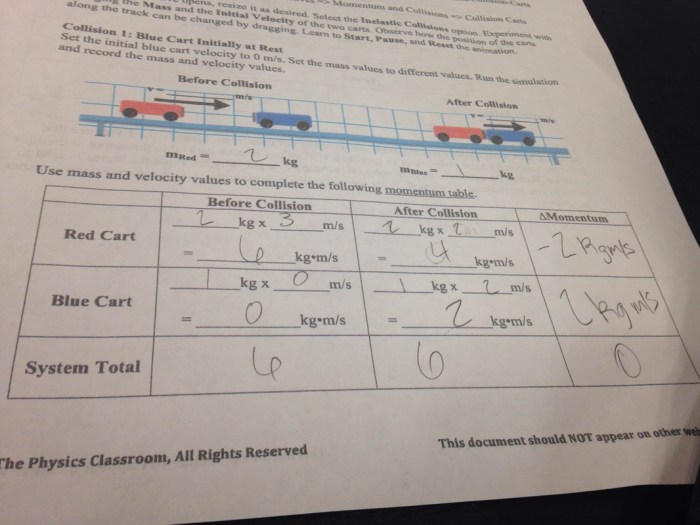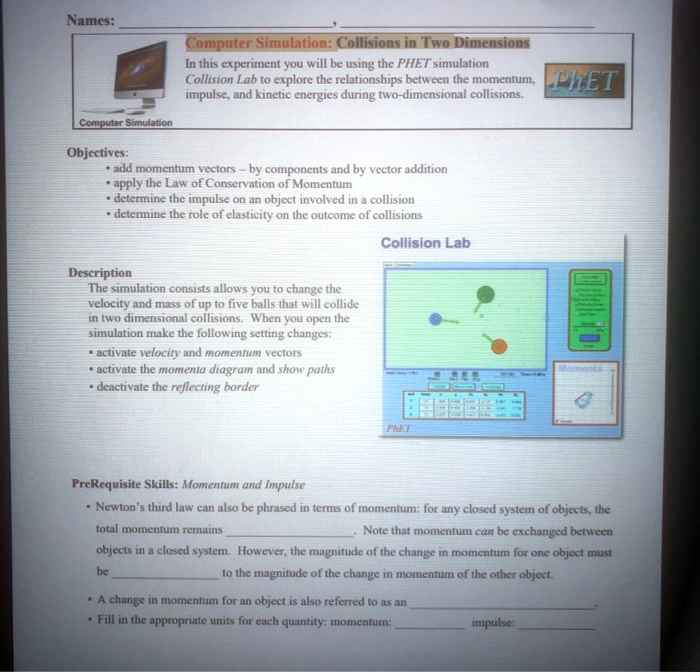Embark on an enlightening journey with the Collisions and Momentum PHET Activity Answer Key, a comprehensive guide that unlocks the intricacies of motion and its governing principles. This interactive resource delves into the fundamental concepts of momentum, providing a hands-on approach to understanding the dynamics of collisions.
Through a series of engaging experiments and simulations, this activity empowers learners to visualize and analyze the transfer of momentum between objects. By exploring real-world applications and extending the activity’s scope, students gain a profound understanding of the role momentum plays in shaping our physical world.
Collisions and Momentum Phet Activity: Collisions And Momentum Phet Activity Answer Key

The “Collisions and Momentum” Phet activity is an interactive simulation that allows students to explore the principles of momentum. The activity provides students with a virtual environment in which they can create and observe collisions between objects.
The purpose of the activity is to help students understand how momentum is conserved in collisions. Momentum is a measure of an object’s mass and velocity. When two objects collide, the total momentum of the system is conserved, meaning that the total momentum before the collision is equal to the total momentum after the collision.
Materials and Equipment
The following materials are required for the activity:
- Computer with Internet access
- Phet “Collisions and Momentum” simulation
The following equipment is used in the activity:
- Virtual objects (e.g., balls, cars)
- Virtual ramps and walls
- Virtual sensors (e.g., velocity sensors, momentum sensors)
Procedures
To conduct the activity, follow these steps:
- Open the Phet “Collisions and Momentum” simulation.
- Create two virtual objects by clicking on the “Add Object” button.
- Set the mass and velocity of each object.
- Place the objects on the virtual table.
- Click on the “Play” button to start the simulation.
- Observe the collision between the objects.
- Use the virtual sensors to measure the velocity and momentum of the objects before and after the collision.
Data Collection and Analysis, Collisions and momentum phet activity answer key
To collect data from the activity, use the virtual sensors to measure the velocity and momentum of the objects before and after the collision. The data can be recorded in a table or spreadsheet.
To analyze the data, calculate the total momentum of the system before and after the collision. The total momentum should be the same before and after the collision, demonstrating the conservation of momentum.
Results and Discussion
The results of the activity will demonstrate the principles of momentum. The total momentum of the system will be the same before and after the collision, regardless of the masses and velocities of the objects involved.
This demonstrates that momentum is a conserved quantity. In other words, momentum cannot be created or destroyed, only transferred from one object to another.
Applications
The principles of momentum have many real-world applications. For example, momentum is used to design airbags in cars. Airbags work by absorbing the momentum of the passenger during a collision, which reduces the force of the impact and helps to prevent injuries.
Momentum is also used in rocket propulsion. Rockets work by expelling mass in one direction, which creates momentum in the opposite direction. This momentum propels the rocket forward.
Extensions
The “Collisions and Momentum” Phet activity can be extended to explore other aspects of momentum. For example, students can investigate the effects of different masses and velocities on the momentum of a system.
The activity can also be used to teach other physics concepts, such as energy and work. For example, students can investigate the relationship between momentum and kinetic energy.
FAQ
What is the purpose of the Collisions and Momentum PHET Activity?
The activity aims to provide an interactive and engaging platform for students to explore the concepts of momentum and collisions, fostering a deeper understanding of their principles and real-world applications.
How does the PHET simulation facilitate learning?
The simulation allows users to manipulate variables and observe the resulting changes in momentum, enabling them to visualize and analyze the dynamics of collisions in a controlled environment.
What are some extensions of the activity?
Extensions can include exploring the effects of different collision types (elastic, inelastic), investigating momentum conservation in more complex systems, and applying momentum principles to real-life scenarios.
